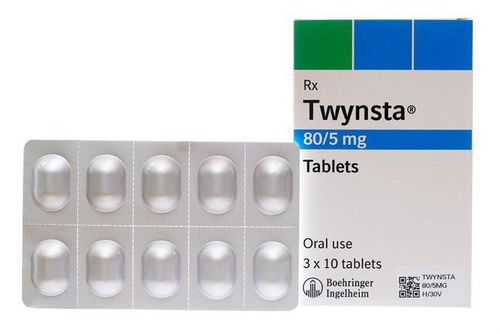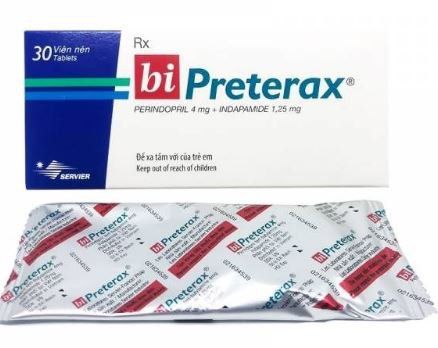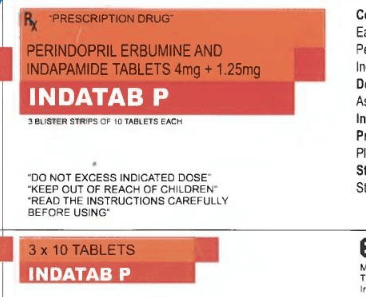This is an automatically translated article.
Preterax is a drug commonly indicated in the treatment of essential hypertension (of unknown cause). Below is all the information about Preterax that patients need to know before being prescribed to use the drug to ensure safety and achieve good results in disease treatment.
1. What is Preterax?
Preterax is a pharmaceutical product manufactured by Les Laboratoires Servier Industrie, France. The drug belongs to the group of cardiovascular and blood pressure drugs in the list of Angiotensin-converting enzyme inhibitors / Direct renin inhibitors with the main ingredients being Indapamide 0.625mg and Perindopril 2mg. The drug is indicated in the treatment of essential hypertension.
Preterax is in the form of tablets and is packaged in boxes of 1 blister x 30 tablets.
2. Uses of the drug Preterax
2.1. Preterax Preterax is a combination of perindopril tert-butylamine salt (an ACE inhibitor) and Indapamide (a Chloro sulfamoyl diuretic). The drug has an antihypertensive effect and increases urine output.
2.2. Indications for Preterax Preterax is usually indicated in the treatment of essential hypertension (of unknown cause).
2.3 Contraindications to Preterax Preterax is contraindicated in the following cases:
In relation to Perindopril:
Allergy to Perindopril or other ACE inhibitors. History of angioedema with previous ACE inhibitor or hereditary/idiopathic angioedema. Pregnant women over 3 months. Regarding Indapamide:
Allergy to indapamide or other sulfonamides. Severe renal failure with creatinine clearance less than 30mL/min). Hepatic encephalopathy. Severe liver failure. Decreased blood potassium. Breastfeeding. In relation to Preterax:
There is a history of hypersensitivity to the components contained in the drug. Preterax should not be used in patients on hemodialysis or in patients with untreated decompensated heart failure.
3. How to use, dosage of Preterax
The drug is used according to the prescription and prescription of a qualified doctor, so the patient needs to take the drug under the guidance of the doctor.
How to use:
The drug is taken orally and should be taken in the morning before breakfast for the drug to work best. Dosage:
Take a single dose of 1 tablet of Preterax per day and if blood pressure is still not controlled after 1 month, double the dose.
Elderly people: Take one tablet per day. Patients with renal impairment: In patients with renal impairment with a creatinine clearance of 30-60 mL/min, the maximum dose is 1 tablet/day. In patients with creatinine clearance ≥ 60 mL/min, no dose adjustment is required. Patients with hepatic impairment: No dose adjustment is required in patients with moderate hepatic impairment, and severe hepatic impairment should not be used. Children and adolescents: Contraindicated. Note: This dose is for reference only, and the specific dose will depend on the condition and progress of the disease. Therefore, it is necessary to consult a doctor to determine the appropriate dose.
4. Preterax drug side effects
When using Preterax, users may experience the following undesirable effects (ADRs):
Common, ADR > 1/100: Headache, dizziness, dizziness, weakness, visual disturbances , tinnitus, hypotension, dry cough, dry mouth, nausea, vomiting, constipation, epigastric pain, abdominal pain, dyspepsia, diarrhea, loss of appetite, taste disturbance, maculopapular rash, rash skin, pruritus, cramps Uncommon, 1/1000 < ADR < 1/100: Sleep disturbance, bronchospasm, facial edema, lips, laziness, extremities, larynx, urticaria, renal failure, impotence, Sweating Instructions for handling ADR:
When experiencing the above side effects of the drug, it is necessary to stop using it and notify the doctor for advice or go to a medical facility for timely treatment.
5. Drug interactions
Concerning Perindopril, Indapamide:
Co-administration of Perindopril and Indapamide with Lithium is not recommended, which may increase lithium concentrations and increase the risk of lithium toxicity. Particular caution should be exercised when concomitant use with Baclofen may affect the potential to lower blood pressure. Nonsteroidal anti-inflammatory drugs including acetylsalicylic acid at high doses reduce the antihypertensive effect of perindopril. Concomitant use of ACE inhibitors and nonsteroidal anti-inflammatory drugs may increase the risk of acute renal failure and impaired renal function, and increase serum potassium levels, especially in patients with pre-existing renal failure. renal function decline. Imipramine-like antidepressants (tricyclic antidepressants), sedatives will increase the antihypertensive effect. Corticosteroids, Tetracosactide will reduce the antihypertensive effect. Concomitant use with other antihypertensive agents may cause excessive hypotension. Concerning Perindopril:
Concomitant use with potassium-sparing diuretics is not recommended, salt-formed potassium supplements reduce the diuretic effect leading to potassium loss. Potassium-sparing diuretics, potassium supplements, or salted potassium can cause significant (possibly fatal) increases in serum potassium levels. Particular caution should be exercised when co-administering with antidiabetic drugs (insulin, hypoglycemic sulphonamides) may enhance the hypoglycaemic effect of the drug. Caution should be exercised when co-administering allopurinol, cytostatic or immunosuppressive agents, synthetic corticosteroids or procainamide may increase the risk of leukopenia. Concomitant use with anesthetic agents may enhance the hypotensive effect of some anesthetic agents. Diuretics (thiazide or loop diuretics) can lead to volume depletion and risk of hypotension. Regarding Indapamide:
Special caution should be exercised when co-administering with drugs with a risk of torsade de pointes such as class IA antiarrhythmic drugs (Hydroquinidine, Disopyramide, Quinidine); class III antiarrhythmic drugs (Amiodarone, Bretylium, Dofetilide, Ibutilide, Sotalol); some sedative drugs (Chlorpromazine, Cyamemazine, Thiroridazine, Leyomepromazine, Trifluoperazin),... need to prevent the risk of hypokalemia due to the risk of hypokalemia. Hypokalemic agents such as Amphotericin B (intravenous), Glucocorticoids and Mineralocorticoids (systemic), Tetracosactide, stimulant enemas increase the risk of hypokalemia (side effects). Cardiac Glycosides: Low serum potassium levels increase the toxicity of cardiac glycosides. Metformin: Causes lactic acidosis due to possible effects on renal function related to the diuretic effect. Contrast containing iodine: In the case of diuretics leading to dehydration, the risk of acute renal failure is increased, especially when using high doses of iodinated contrast agents. Calcium (salt): Increases the risk of hypercalcaemia due to decreased urinary excretion of calcium.
6. Notes and cautions when taking Preterax
When using Preterax, patients need to pay more attention and caution to the following issues to ensure safety when taking the drug:
The drug is only used when prescribed and prescribed by a qualified doctor. You need to take the medicine exactly as prescribed, do not adjust the dosage without your doctor's prescription. Perindopril should be used with caution in patients with collagen vascular disease, being treated with immunosuppressants, allopurinol or procainamide, or using a combination of these factors, particularly in patients who are already impaired. Pre-existing renal function because of possible neutropenia, agranulocytosis. Edema of the face, lips, tongue, and extremities has been reported rarely in patients treated with ACE inhibitors, including perindopril. If any of these side effects occur, treatment with Perindopril should be discontinued immediately and an appropriate control regimen should be established to prevent these symptoms in advance. Perindopril should not be used in combination with potassium-sparing diuretics or potassium salts. For pregnant and lactating women, the drug should not be used to avoid affecting the pregnancy and young children. The two components of the drug alone do not affect the ability to drive and use machines. However, in some patients may occur side effects related to hypotension, should not drive, operate machinery when this side effect.
7. Missed dose, overdose of Preterax
Missed dose: Take as soon as you remember as soon as possible within 1-2 hours of the prescribed time, but if it is almost time for your next dose, skip the missed dose and take the next scheduled dose. Do not double the dose to make up the dose to avoid overdose or increase the side effects of the drug.
Overdose: If an overdose occurs, the drug should be rapidly eliminated from the body by intestinal lavage and/or oral activated charcoal. Then, give fluid and electrolyte balance at a specialized medical facility until these indicators return to normal.
If there is significant hypotension, the patient should be placed in the supine position with the head lowered. If intravenous isotonic saline is required or volume expansion measures can be used in a medical facility.
8. Preterax drug storage
The medicine should be stored in a dry place with a temperature of 15-30 degrees Celsius, away from sunlight and moisture. It is necessary to cancel the blister pack after 2 months when opening the medicine box.
It is necessary to keep the medicine out of the reach of small children so that the child does not play and take the medicine when it is not recommended.
For drugs that are no longer in use or expired, they should be safely destroyed according to the instructions of a doctor or local waste disposal company. Note that the medicine should not be flushed under the household tap or thrown into the toilet.
The above information about Preterax medicine provided above is for reference only. In order to use drugs safely, effectively and at the right dose to achieve good results in treatment, patients need to contact a qualified doctor for the most appropriate advice, indication and prescription.













